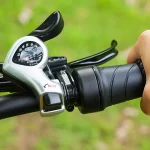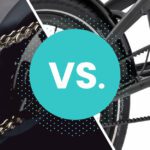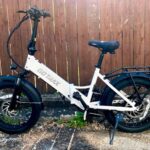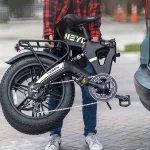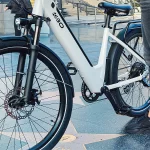A common question with regard to electric bikes, is whether it’s OK to ride them in the rain. After all, traditionally water and electrics don’t mix. If you’ve spent a lot of your hard-earned money on an electric bike, you don’t want a sudden downpour to damage it.
You should expect any electric bike to be fine for riding in the rain, at least when it’s not during a heavy downpour. Electric bike manufacturers aren’t daft. They are well aware you’re exposed to rain sometimes, since cycling is an outdoor activity. So, electric bikes are generally built to withstand riding in wet conditions.
You should still be careful when riding (and even storing) your electric bike in wet conditions though. You want to reduce any chance of damage and wear and tear, as much as possible.
There are particular situations where your electric bike can come into contact with water, which you should be cautious of. For example, submerging your electric bike in water could cause damage. This can happen, if you are cycling through a deep stream, or through a flooded trail. Likewise, riding through a heavy downpour, could also cause some damage. These events could also speed up any wear and tear.
In this article, I will talk about the actions you can take, to minimize your electric bike’s contact with water. This will help you to prolong the life of your bike. Before I go any further, though, below is a table, outlining some tips to help prevent water damage on your electric bike.
Table of Contents
Waterproof Versus Water Resistant
It’s worth mentioning that electric bike components are water resistant, not waterproof. This is pretty much the same for any electrical equipment, like mobile phones. The difference between waterproof and water resistant is as below.
Waterproof – Completely impervious to water.
Water resistant – Able to resist the penetration of water to an extent, but not 100% completely.
This backs up the fact, you should still be careful with riding electric bikes in wet situations. This applies to storing your electric bike as well. You shouldn’t be careless and take unnecessary risks.
The Importance of Electric Bikes Being Water Resistant
When considering how water resistant an electric bike is, the electrical components are most important. Although other components, like the frame, can be prone to increased rusting if exposed to water. If water was to get into any of the electrical components, it can stop them from working. This will stop the whole electric assistance on the bike, from working as a result. These electrical components are expensive to replace as well. The electrical components on the bike that can be exposed to rain, are as below:
- Motor
- Battery
- Control panel/LCD Display
- Cables
As referred to earlier, electric bikes can handle rain in general. But there are certain more extreme wet situations, you should be careful of. These situations can cause damage, or premature rusting, and can include the below:
- Submerging the bike in water
- Subjecting the bike to a pressure washer
- Being caught in a heavy downpour
- Storing the bike outside, potentially exposing it to a lot of rain, over a lengthy period
- Being exposed to heavy splashes
- Leaving the bike on a roof rack, whilst exposed to rain
If you have an electric bike, you want it to be as water resistant as possible, if it incurs any of the above situations. This is to reduce any chance of damage. It’s best, though, to avoid these situations altogether, if possible. Especially since certain electric bikes are more water resistant than others. You can avoid these situations altogether, or at least minimize their impact, by taking certain precautions.
I will talk about these precautions further, in this article. Also, I will talk about the above mentioned electrical components, with regard to their water resistance.
But, before I do this, I will talk about something called an IP rating (below). This will help with discussing further about electric bike’s water resistance.
IP Rating
IP Rating, is a universal rating of how resistant an electrical item is to dust and water. The higher the IP rating, the more resistant the item concerned is to water and dust.
IP ratings consist of 2 numbers. Below describes what these 2 numbers relate to.
- The 1st number, relates to how resistant an item is to dust.
- The 2nd number, relates to how resistant an item is to water.
The number relating to an item’s dust resistance, can range between 0 and 6. With 0 being not rated at all for resistance to dust and 6 being fully resistant to dust. The number relating to water resistance, can be anything between 0 and 8, with an extra rating of 9K (that’s above 8). Here, 0 means not rated at all for resistance to water and 9K, is the highest level of water resistance.
An example of an IP rating could be IP27. This rating would mean the item concerned, does not have much resistance against dust. But it would have a high level of resistance, against water.
If you want further, more detailed and specific information about IP ratings. Then you can look at this article “The Comprehensive Guide To IP Ratings”.
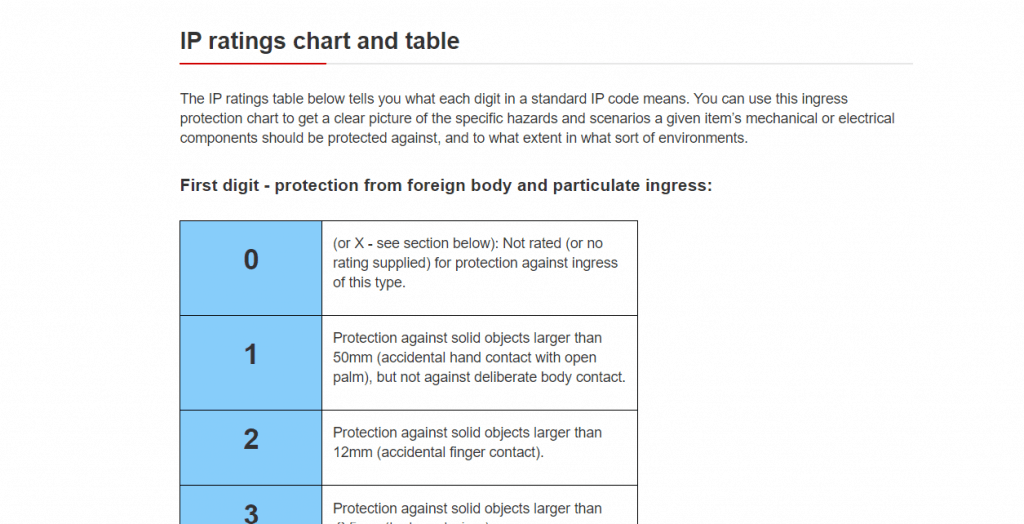
Now as promised, I will talk about the below, throughout the rest of this article.
- The precautions you can take, to minimize your electric bike’s contact with water.
- The individual electrical components, with regard to their water resistance.
Motor and Battery
Both of these components are expensive, not to mention important. So you don’t want to take any avoidable risks, by exposing them to more water than necessary. For example, if heavy rain has been forecast, it’s best to avoid cycling that day. If you have a necessary journey though, like a commute, you may have to weigh things up.
You should also avoid riding through deep puddles and streams, where these components can be submerged. This is more likely if they’re positioned low down on your bike. Mid drive motors are always situated low down on electric bikes. So you should be especially careful to avoid riding through deep water, if you have this type of motor.
If you have a low situated battery and/or a mid drive motor and you expect there’s a good chance of coming across puddles and streams, whilst riding. For example, if you’re planning on riding on off-road trails. You could make sure your battery and motor has an IP rating of at least 7, for the 2nd number. The number that’s related to water resistance.
This would be a precautionary measure, in case you come across any unavoidable deep water situations. For example, if an off-road trail is flooded. Again, it’s recommended avoiding these components from being submerged altogether though.
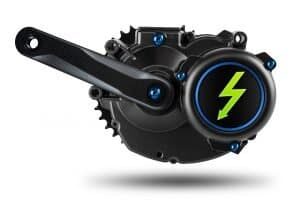
You may also want a battery and a motor with a high IP rating, if you live in a particularly rainy area. Do bear in mind, though, that not all electric bike batteries and motors will have an IP rating. Or at least not have a high IP rating. So there will be an amount of searching involved.
As an extra caution, you can buy water resistant covering for your electric bike battery.
Control Panel/LCD Display
Your control panel will likely be less water resistant, than your battery and motor. It will still be water resistant though, but again not waterproof.
So, if you want to be extra cautious, you could carry a clear plastic bag whilst riding, in say a pannier or a backpack. You can place this bag over your control panel and fasten it on with an elastic band, if a heavy downpour occurs. The clear bag will allow you to still see the LCD display on the control panel, whilst protecting it from heavy rain.
This can give you the confidence to ride your electric bike in the rain, if the control panel does not have a high IP rating. Again, some control panels may not even have an IP rating. Bear in mind, that if your control panel was to get too much water inside it during a heavy downpour, it could cut out. This will stop the electric power to the rest of your bike.
The Cables
Your electric bike will have cables that link the electrical components. For example, from the controller to the motor. You should expect these to also be water resistant during rain and in the event of splashes. However, the cables, as part of an electric bike conversion kit, tend not to be very water resistant. These conversion kits are to convert a regular bike to an electric bike, by the way.
You can take extra caution here as well, to make these cables more water resistant. This is beneficial whether they are as part of a conversion kit, or a pre-built electric bike.
You can place something called heat-shrink over the cables to cover them. This heat-shrink is not watertight though (can still let water in), unless you fill it with gel. This gel covers all the space between the cable itself and the inner wall of the heat-shrink. Without using this gel, heat-shrink on its own is not always an effective option.
A better option is to use a special type of heat-shrink that you can heat up, so the inner layer melts around the cable. This creates a watertight seal. You may find this an easier task to carry out, compared to filling heat-shrink with gel.
This type of heat-shrink comes in different ratios, like 2:1, 3:1 and 4:1 etc.
These ratios relate to how much the heat-shrink can be shrunk down to. For example, if the ratio is 2:1, then it can be shrunk to half its size. Likewise, if the ratio is 3:1, then it can be shrunk to a third of its size and so on. With this is mind, the thinner the cable, the bigger you want the ratio to be. This is so that the heat-shrink wraps around the cable, to form a watertight seal.
Pressure Washing
To help with the general maintenance and longevity of your electric bike, it’s a good idea to clean it regularly.
If you are going to clean your electric bike though, it’s advisable to avoid using a pressure washer.
Using a pressure washer can be tempting though. This is because it’s an effective way to blast off dirt and mud, without you having to give your bike a good solid scrub. Nonetheless, cleaning your electric bike this way is risky. You could be subjecting your electrical components to potential damage.
Even if your electric bike components are OK against rain, a pressure washer is a whole different ball game. This results from the high pressure of the water.
The highest IP rating (for the water resistance part) of 9K, specifies protection against high pressure washers. But even if the electrical components on your electric bike were to have this IP rating. I would still recommend you avoid using a pressure washer on your bike. It’s best to avoid the unnecessary risk in the first place, regardless of any IP ratings the components may have.
Aside from the electrical components on your electric bike. It will have various sealed bearings throughout. These can start rusting, if water gets into them from a pressure washer.
Additionally, a pressure washer can move gravel and dirt into the electrical components. This can cause damage, if any electrical components are not impervious to dust and particles.
To help avoid any temptation to use a pressure washer, you can clean your electric bike as soon as you finish a ride. If you clean your bike straight away after a ride, you can remove any dirt and mud before it dries on.
Using Fenders (Mudguards)
Having Fenders on your electric bike is an effective way to reduce water splashes and mud, from getting onto it. Like with rain, your electric bike should generally withstand splashes. Although, some splashes can hit your bike with bigger force than others. This is depending on how fast you ride through a puddle. So fenders help you to be safe, rather than sorry.
Reducing the amount of mud and dirt hitting your bike during a ride, will make your bike easier to clean afterwards. This will help further reduce any temptation you may have, to use a pressure washer. The easier your bike is to clean after a ride, the less water you will need in general to clean it. Your electric bike will be less likely to suffer from rust, the more fenders deflect water away from it.
Having fenders on your electric bike is especially beneficial, if you’re out riding on off-road trails a lot.
General Maintenance
It stands to reason, the more you look after your electric bike, the longer it will last. As part of doing this (with regard to your electric bike coming into contact with water), you can take advantage of the below tips.
- Use a water resistant spray, to help protect your electric bike against rust. A suitable option is Muc-Off, which has been produced especially for electric bikes.
- Make sure you wipe your electric bike down, straight after you have been out for a ride in the rain. If you leave your bike wet after a ride, then this can cause, or enhance, rust.
- If you’re cleaning your bike with either a wet sponge or wet cloth, make sure they are not wetter than necessary. Muc-Off also provides a waterless wash, which again, is especially for electric bikes.
- It is a good idea to remove the battery, whilst cleaning the rest of your bike.
A little bit of investment, in both time and money, can help prevent you from having to spend more money, replacing parts later on.
Storage
Even though you can expect your electric bike to be OK in rain, you should still minimize its contact with rain. With this in mind, you should (if you can) store your electric bike indoors. This will mean not exposing your bike to heavy downpours unnecessarily. It will also mean that your bike is not exposed to more rain, in general, than necessary. Following this step, will again reduce any chance of damage and rust.
You may be unable to store your electric bike indoors though, due to a lack of space. If this is the case, then there are the 2 below possible resolutions, to still protect your bike from rain.
- Buy a waterproof cover for your electric bike.
- Buy a foldable electric bike. You may be able to store a foldable electric bike indoors, if you don’t have the space indoors for a non foldable bike.
Attaching your electric bike to a roof rack, can also expose it to more rain than usual. This may be unavoidable though, if you go on cycling holidays, or drive out to cycling trails. Again, having a foldable electric bike, can provide a resolution here as well. This could allow you to store your bike in your car boot, instead of on a roof rack.
Conclusion
The theme here, throughout this article, is to keep your electric bike’s contact with water as minimal as possible. Especially in extreme scenarios. Electric bikes are not usually cheap. So you want to do your best, to make sure your electric bike lasts as long as possible.
Your electric bike may be able to survive a pressure washer clean, or riding in heavy rain. But it’s not worth taking any unnecessary risks. Even if your electric bike were to survive a pressure washer clean once, it may not do so the next time. This can also be the case, with regard to riding through deep streams.
In the worst case scenario though, if water was to ever cause damage to your electric bike. It’s likely that only one component in particular would be damaged, rather than the whole bike. In which case, the part would need replacing instead of the bike itself. Having said this though, it’s still always best to avoid the expense.
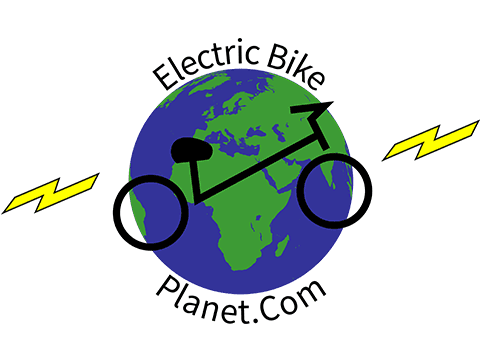
Captain Colyer is an expert in sustainable transportation with a Master’s degree in Environmental Engineering. With over 9 years of experience, he is dedicated to advancing eco-friendly commuting solutions. His work focuses on the latest advancements in electric bike technology and promoting sustainable living practices. At ElectricBikePlanet.com, Captain Colyer shares his in-depth knowledge and practical insights to help readers make informed decisions about electric bikes. Join them on their electric journey for the best e-bike advice and recommendations, and connect on Facebook, Pinterest, and Instagram.


